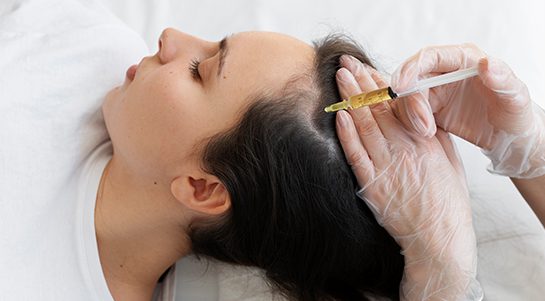PRP Hair Treatment
Platelet-rich plasma (PRP) therapy for hair loss is a three-step medical treatment in which a person’s blood is drawn, processed, and then injected into the scalp. Some in the medical community think that PRP injections trigger natural hair growth and maintain it by increasing blood supply to the hair follicle and increasing the thickness of the hair shaft. Sometimes, this approach is combined with other hair loss procedures or medications. Platelets, the tiny cell fragments in our blood responsible for clotting and healing, are concentrated through a simple blood draw and the resulting PRP is then carefully injected into the scalp at strategic points.
Table of Contents
ToggleUnderstanding Platelet-Rich Plasma
PRP is a concentrated solution derived from the patient’s blood, enriched with a higher concentration of platelets than normal blood. Platelets are tiny cell fragments that play a crucial role in the body’s natural healing process. In the context of hair treatment, Platelet-Rich Plasma is harnessed for its regenerative properties to stimulate hair follicles and encourage hair growth.
How PRP Works for Hair Treatment
Platelet-rich plasma works by harnessing the growth factors within the platelets to stimulate dormant or weakened hair follicles. These growth factors promote the proliferation of cells, enhance blood circulation, and stimulate collagen production and as a result, the hair follicles become revitalized, leading to improved hair thickness, strength, and overall health.
The PRP Hair Treatment Process
A small amount of the patient’s blood is drawn usually from the arm and the collected blood is then processed in a centrifuge machine which separates the platelet-rich plasma from other blood components. The PRP is activated to release growth factors which are proteins that play a key role in cell regeneration and tissue repair, then the activated PRP is injected into the targeted areas of the scalp where hair thinning or loss is evident.
Frequently Asked Questions 0n Platelet-Rich Plasma Hair Treatment
1. Can PRP be Combined with Other Hair Restoration Treatments?
Yes, Platelet-Rich Plasma can be used in conjunction with other hair restoration methods, such as topical treatments or laser therapy to enhance overall results. Consulting with a healthcare professional can help determine the best combination for individual needs.
2. Is PRP Suitable for Both Men and Women?
Yes, PRP is considered a versatile hair treatment option and is suitable for both men and women experiencing various types of hair loss or thinning.
3. Are the Results of PRP Hair Treatment Permanent?
While PRP can stimulate hair growth and improve the health of existing hair, it may not stop the progression of underlying causes of hair loss. Maintenance sessions may be recommended to sustain results over time.
4. Does PRP Hurt?
Discomfort during PRP injections is usually minimal. Some practitioners use a local anesthetic to numb the scalp before the procedure to ensure patient comfort.
5. How many PRP Sessions are Required for Visible Results?
The number of sessions can vary depending on individual factors such as the extent of hair loss and the desired results. However, many practitioners recommend an initial series of treatments, often spaced a few weeks apart, followed by maintenance sessions.
6. Is there any Downtime after a PRP Hair Treatment Session?
Generally, there is minimal downtime after a PRP session. Some patients may experience mild redness or swelling at the injection site, but this usually resolves within a day or two.
7. When can One Expect to see Results from PRP Hair Treatment?
Results vary among individuals, but some patients may start noticing improvements after a few months. However, it’s important to note that the full effects may take several months as the hair growth cycle progresses.
8. What is Platelet-Rich Plasma (PRP) and how does it Work for Hair Treatment?
PRP is a concentrated solution derived from the patient’s blood, enriched with a higher concentration of platelets. When injected into the scalp, PRP releases growth factors that stimulate hair follicles, promoting cell regeneration and tissue repair for improved hair growth.
9. Is PRP Safe for Hair Treatment?
Yes, PRP is generally considered safe for hair treatment since it is autologous, meaning it comes from the patient’s blood. This minimizes the risk of allergic reactions or adverse effects.
10. How long does a Typical PRP Hair Treatment Session Take?
A Platelet-Rich Plasma hair treatment session typically takes about 60 to 90 minutes, this includes the time for blood collection, processing, and the actual PRP injection.
Conclusion
PRP treatment offers several advantages, including its autologous nature, minimal risk of adverse reactions, and relatively straightforward procedure. Patients appreciate the non-invasive nature of the treatment and the fact that it utilizes their blood components, reducing the likelihood of allergic reactions or rejection. Moreover, the procedure is generally well-tolerated with minimal downtime, making it an attractive option for those seeking non-surgical interventions. In conclusion, Platelet-Rich Plasma (PRP) hair treatment has emerged as a promising and innovative approach in the field of hair restoration


Leave a Reply